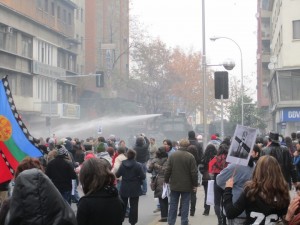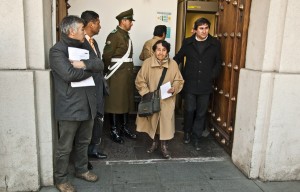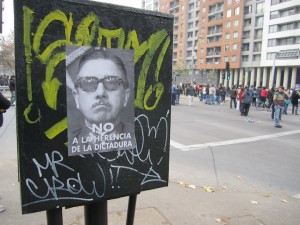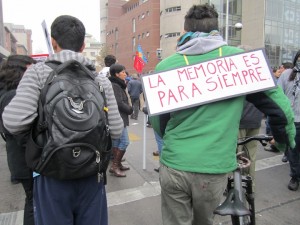Letters from Chile: A dead dictator's homage, a public history movement (Part 1)
25 June 2012 – Zachary McKiernan
politics, Letters from Chile, advocacy, social justice, public engagement, memory, government, human rights, international
This past Sunday, June 10, the right-wing Corporation 11 de Septiembre held an homage to the dead dictator Augusto Pinochet under the auspices of a documentary screening at the iconic Teatro Caupolican in Santiago Centro. That day it was answered and challenged in sometimes violent ways by diverse sectors of society and weeks before when many of Santiago’s notably non-violent human rights organizations and sites of memory maneuvered to use legal and political recourse to prevent a ceremony that celebrated a leader infamous for overseeing an era of human rights violations. After these efforts were exhausted and the Chilean Courts came back with an answer that allowed the planned activity to take place, it became apparent that the battle for history and memory would manifest that day in the streets and sidewalks around Teatro Caupolican. Footage of the action in the streets can be seen here.
The funa (a public “outing” of human rights violators and accomplices by human rights activists; in Argentina and Uruguay, escrache) that offered the popular answer to the Pinochet homage was an emblematic example in my recent research and public history explorations here which suggest there is a keen interest on behalf of many sectors of Chilean society in keeping alive the histories and memories of the recent past (and also that the state still maintains a tacit stance about thorny human rights issues). These “Letters from Chile” began as an exercise in examining the working of history at six sites of memory. The series ends at a coordinated effort between these and other memory sites and human rights organizations to stop and then “out” an homage to a dead dictator.
In fact, a few days before the event, as a member of the Nido 20 team, I went to lend my support to submit an open letter to President Sebastian Piñera at the presidential palace, La Moneda. Signed by four of the six sites reviewed in this series (Memorial Nido 20, Fundación 1367 José Domingo Cañas, Corporación Paine, and Corporación Parque de la Paz Villa Grimaldi) plus eleven other human rights organizations and one politician, the document appeals to what human rights activist identify as the right side of history, and declares that “to execute an homage to a dictator is an act of extreme violence that makes vulnerable the recent history of our nation, still with painful wounds from the crimes committed and for the lack of truth and justice.” The sixteen signers affirmed that they have a “moral duty with history” to manifest their opposition publicly if the homage went forward.
When I arrived to the funa at the appointed time a few blocks from Teatro Caupolican, I saw the same faces I saw at La Moneda, the same people I had seen at Santiago’s many sites of memory since my arrival to Chile, the same human rights activists that had (democratically) overthrown the dictator some two decades ago. But I also saw new faces: the enlivened youth from the población (shantytown or popular barrio) Villa Francia, scores of student, religious, and political organizations, and, in opposition to the opposition, young Pinochetistas holding up posters of the dictator with a single word below his bust: Gracias. I remember thinking, “This is how history works, this is history working in Chile, this is the contest and contents of an historically engaged citizenry.” Through this act and six sites of memory in Chile—plus numerous other public sites, archives, and commemorations not covered in this series—I have observed history working in various forms in various ways: personal and political histories, neighborhood and oral histories, and as an activist tool in street protests, social movements, and human rights practice. What is right to remember is that in Chile these diverse and notably public uses of history share a distinct common denominator: they are all connected to the political past, the umbrella of revolution, the shadow of dictatorship, and now a hope for a more democratic future.
In the same sense that Louis Bickford describes Chile’s famed human rights movement as a direct result of dictatorship (“Preserving Memory: The Past and the Human Rights Movement in Chile,” Democracy and Human Rights in Latin America, Richard S. Hillman, John A. Peeler, and Elsa Cardoza da Silva, eds., 2002, pp. 9-26), so too is the dictatorship responsible for Chile’s special engagement with history and the urgency of memory/memory-making in the historical present. When one speaks in Chile of “historic memory” or “historic memory work” it is most always in reference to the dictatorial past and, therefore, equally associated with the arena of human rights. Elizabeth Jelin writes that “With respect to the dictatorships of the Southern Cone, the human rights movement has been and continues to be a privileged actor in the political enterprise of memory” (State Repression and the Labors of Memory, 2003, pg. 34). Jelin’s “memory entrepreneurs” are those “who seek recognition and political legitimacy of one (their own) interpretation or narrative of the past.” That these interpretations and narratives often challenge and counter “official” history is also important to know. In this context, the public’s keen interest in the past is an answer to the state’s inadequacy in addressing the human rights violations that occurred between 1973 and 1990—an inadequacy reflected in the now frequently cited words of the transition’s first president, Patricio Alwyn, “justicia en la medida que posible” (justice to the extent possible). If I have learned anything while visiting and knowing the actors or “memory entrepreneurs” connected to human rights historical projects here, it is that there lingers an extreme dissatisfaction in how human rights issues (truth, justice, reparation) were handled under Chile’s Concertación governments between 1990 and 2010. That Chile’s transition is incomplete is something that I heard on more than a few occasions.
Through this I have also seen that popular expectations and expressions of human rights practices contrast considerably with official discourse and policy—and even the academic circles–that advance Chile’s “post-transition.” Although significant gains have been made, especially under Michelle Bachelet (2006-2010), most historic memory initiatives have been from the bottom-up. Five of the six Chilean member sites of the International Coalition of Sites of Conscience attest to this (The Museum of Memory and Human Rights is the exception). However, they also attest to the unevenness and uneasiness of these endeavors. Speaking solely of sites of memory, Villa Grimaldi Peace Park and National Stadium, National Memoryappear worlds apart. The guided tour I took at Jose Domingo Cañas 1367 with the son of a detained-disappeared person turned out to be much more a personal story than a contextualized narrative of the site or the political process that gave shape to it. State-sponsored projects such as the Museum of Memory and Human Rights stand in sharp contrast to the state’s authorization of Sunday’s homage to Pinochet. It is also worth mentioning that the six sites reviewed in this series represent only a fraction of what I have seen and experienced. The working of history and/as human rights activism in public places is manifest in a multitude of other sites of memory (Londres 38, Tres y Cuatro Alamos, Memorial Curacavi, for example) and historically-oriented projects (archives, art, protests, etc.). Many times these come together as a confluence. Other times they operate in their own right. But at the end of the day historians, sociologists, psychiatrists, activists, artists, actors, students, and countless others are taking up issues related to the recent past.
In the second half of this post I will consider how this relates to public history practice and discourse.
~ Zachary McKiernan








1 comment